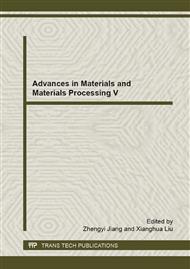p.329
p.333
p.341
p.345
p.349
p.355
p.359
p.363
p.367
Preparation of Sodium Paeonolsilate Intercalated into Layered Double Hydroxides and its Release Properties
Abstract:
A controlled release composite has been prepared by intercalation of sodium paeonolsilate (PAS) into Mg/Al layered double hydroxide (LDH) with the molar ratio (M2+/M3+) of 2:1. The powder X-ray diffraction (XRD) and Fourier transform infrared spectroscopy (FT-IR) confirm the intercalation of PAS into the galleries of LDH. The chemical composites of PAS-LDH were revealed by elemental analysis. Release tests of the PAS-LDH composite showed that no burst release phenomenon occurred at the beginning stage and a high release ratio of PAS (89.8%) was obtained, exhibiting controlled release behavior. Furthermore, the parabolic diffusion model was used to simulate the release kinetics of PAS from the LDH carrier, indicating that the intraparticle diffusion via ion-exchange is the rate-determining step in the release process. It is significance in this work for introducing the PAS-LDH composite to develop antifouling materials with long-term activity.
Info:
Periodical:
Pages:
349-354
Citation:
Online since:
March 2015
Authors:
Price:
Сopyright:
© 2015 Trans Tech Publications Ltd. All Rights Reserved
Share:
Citation:


